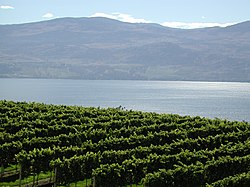Okanagan Valley
The Okanagan Valley is a region in southern British Columbia ; it is also known as Okanagan and forms the Canadian part of the Okanagan Country region .
Location and structure
The Okanagan Valley stretches about 175 kilometers from Osoyoos to Enderby.
The region is made up of three regional districts:
- Regional District of North Okanagan (7,512.58 km²) with administrative headquarters in Coldstream
- Regional District of Central Okanagan (2,904.00 km²) with administrative headquarters in Kelowna
- Regional District of Okanagan-Similkameen (10,413, 44 km²) with administrative headquarters in Penticton
According to the 2001 census, around 298,000 people live on an area of 20,829 km² ; the population density of 14.31 inhabitants per km² is well above average for the inland areas of the province.
history
The valley is home to the Okanagan Nation, a Salish tribe who settled the Okanagan Valley along the Okanagan River to the Columbia River and the Similkameen Valley . These indigenous people lived as hunters and gatherers and traded with peoples of the northwest.
The first foreigners came to the valley in 1811, and 15 years later the Okanagan Trail from Fort Okanagan , a trading post of the Pacific Fur Company on the Columbia River, to the Thompson River valley was used to transport goods to and from the Pacific. The Oregon Compromise divided the valley in 1846 at the 49th parallel , which brought the exchange of goods over the Okanagan Trail to a standstill, as this now took place through the valleys of the Thompson River and the Fraser River towards Vancouver .
It was not until 1859, when Father Charles Pandosy a mission of the Oblates founded in what is now Kelowna, the settlement of the region began, even to the Fraser Canyon and Cariboo Region active prospectors to supply with food. Prospectors who came from the United States via the Okanagan Trail discovered modest deposits of gold and copper in the south of the valley , the exploitation of which led to a further increase in the population.
The economic upswing in the 20th century was initially closely linked to commercial fruit growing, and in 1892 the first apple orchard was planted. This industry led to an economic upswing in the valley, and the woodworking industry was particularly important in Penticton. Viticulture followed later (see also the article Viticulture in Canada ).
Natural space and climate
The Okanagan Valley is the Canadian portion of the valley of the Okanagan River , a river which has its source in Okanagan Lake and flows into the Columbia River in Washington state . The north-south oriented, four to 19 kilometers wide valley is bordered by the Monashee Mountains (with the Okanagan Highland) and the Thompson Plateau .
The lakes, which occupy a large part of the valley, are characteristic of the region:
- Okanagan Lake
- Swan Lake
- Goose Lake
- Kalamalka Lake
- Wood Lake
- Ellison Lake
- Skaha Lake
- Vaseux Lake
- Tuc-El-Nuit Lake
- Osoyoos Lake
The climate is exceptionally warm and dry, with summer temperatures above 30 ° C being common. The winter temperature is also relatively mild, Okanagan Lake and Skaha Lake do not freeze over completely in normal years. Since there are an average of 150 frost-free days, the area is suitable for growing special crops.
The drought increases from north to south, around Osoyoos significantly less than the average of 400 mm of precipitation per year given for the valley.
The valley is known as the Ticino of Canada , the hilly landscape is covered in the north with loose forests mainly of Ponderosa pine and Douglas fir . The arid area in the south near the border with Washington State has desert features, the population of Ponderosa pines is less dense and interspersed with areas covered with cacti and sagebrush . Despite the relatively dense population, larger predators such as black bears and lynxes are still relatively common in the peripheral areas .
economy
Fruit growing is still important today, but is losing acreage in favor of growing wine. The harvest is also offered at stalls along the main thoroughfares:
- Cherries (late June to late July)
- Apricots (mid-July to mid-August)
- Peaches (late July to mid-September)
- Pears (mid-August to mid-September)
- Apples (mid-August to mid-October)
- Plums (early September to late September)
- Grapes (early September to early October)
In addition to the processing of agricultural products, tourism is an important economic factor. In addition, the area is very popular with retirees as a retirement home due to the climatic conditions.
Infrastructure
Kelowna ( YLW ) and Penticton ( YYF ) have airports served by Calgary , Cranbrook , Toronto , Vancouver and Victoria ; Kelowna is also served from Seattle-Tacoma .
Coming from Sicamous, a line operated jointly by the Canadian Pacific and Canadian National Railway offers the possibility of freight transport to Vernon and Kelowna.
The main roads that open up the area are:
- Highway 3 ( Crowsnest Highway )
- Highway 6
- Highway 33
- Highway 97 (Okanagan Highway)
- Highway 97A
- Highway 97C (Okanagan Connector)
Localities
The following villages - arranged from north to south - make up the region:
- Enderby
- Armstrong
- Spallumcheen
- Vernon
- Lumby
- Coldstream
- Lavington
- Lake Country (consisting of Oyama, Winield, Carr's Landing and Okanagan Center)
- Kelowna
- Westside (consisting of Lakeview Heights, West Kelowna and West Bank)
- Peachland
- Summerland
- Naramata
- Penticton
- Caledas
- Okanagan Falls
- Olalla
- Oliver (including Fairview)
- Osoyoos
Web links
- Okanagan Valley - Official Website, (English)
Coordinates: 50 ° 21 '59.9 " N , 119 ° 21' 0.5" W.



